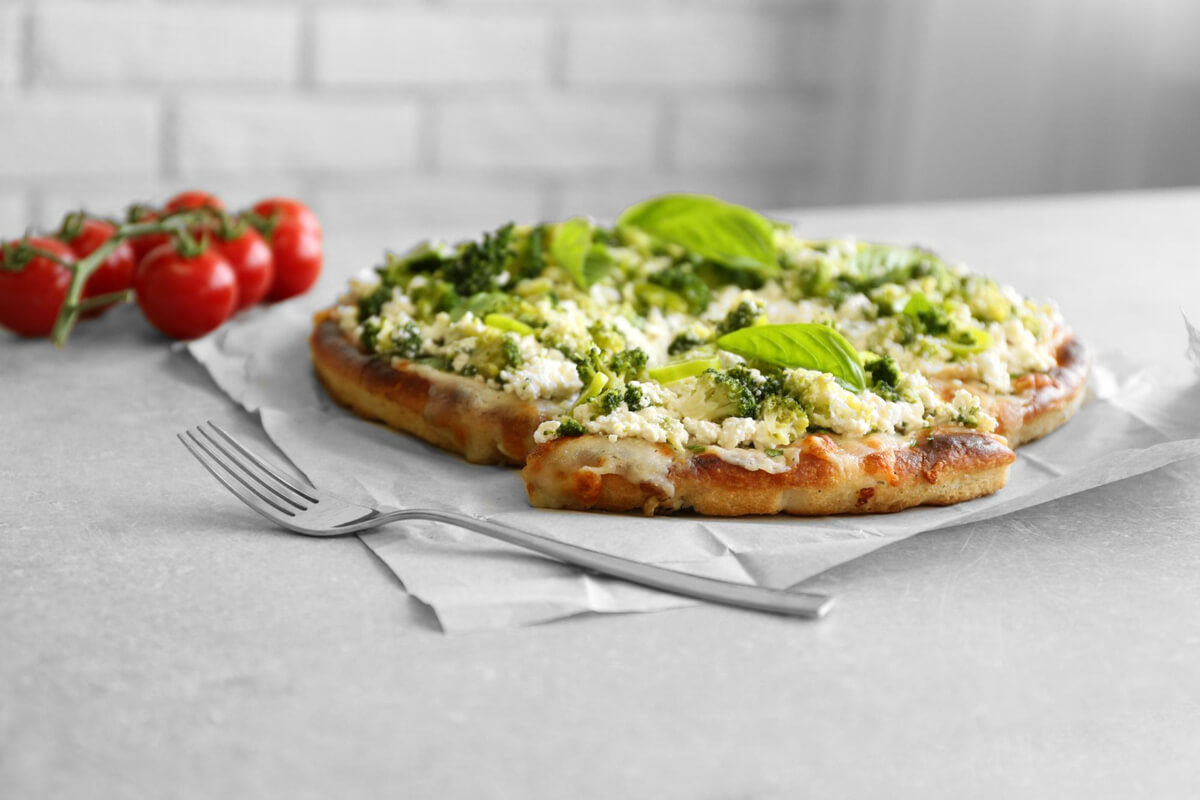Introduction
Pizza is one of the world’s most loved comfort foods, but traditional crusts often come with carbs, gluten, and dairy that some prefer to avoid. Enter the vegan cauliflower pizza crust recipe, a game-changer for anyone seeking a healthier alternative without compromising on taste. This versatile crust is naturally gluten-free, dairy-free, and low in carbohydrates, making it perfect for plant-based diets and those with specific dietary needs.
What makes this recipe stand out is its adaptability. You can make it with no flour, skip the oil, or opt for a quick three-ingredient version. The result? A crispy, flavorful base ready for your favorite toppings.
In this guide, we’ll walk through every step of creating this nutritious crust, share tips to achieve the perfect texture, and troubleshoot common challenges like, “Why does my cauliflower pizza crust fall apart?” By the end, you’ll be ready to craft a pizza that’s both delicious and guilt-free.
Why Choose a Vegan Cauliflower Pizza Crust?
When it comes to pizza, the crust often defines the experience. However, many traditional options come loaded with refined carbs, gluten, and dairy that might not fit into every diet. A vegan cauliflower pizza crust recipe is a healthier alternative that offers incredible benefits without sacrificing flavor.
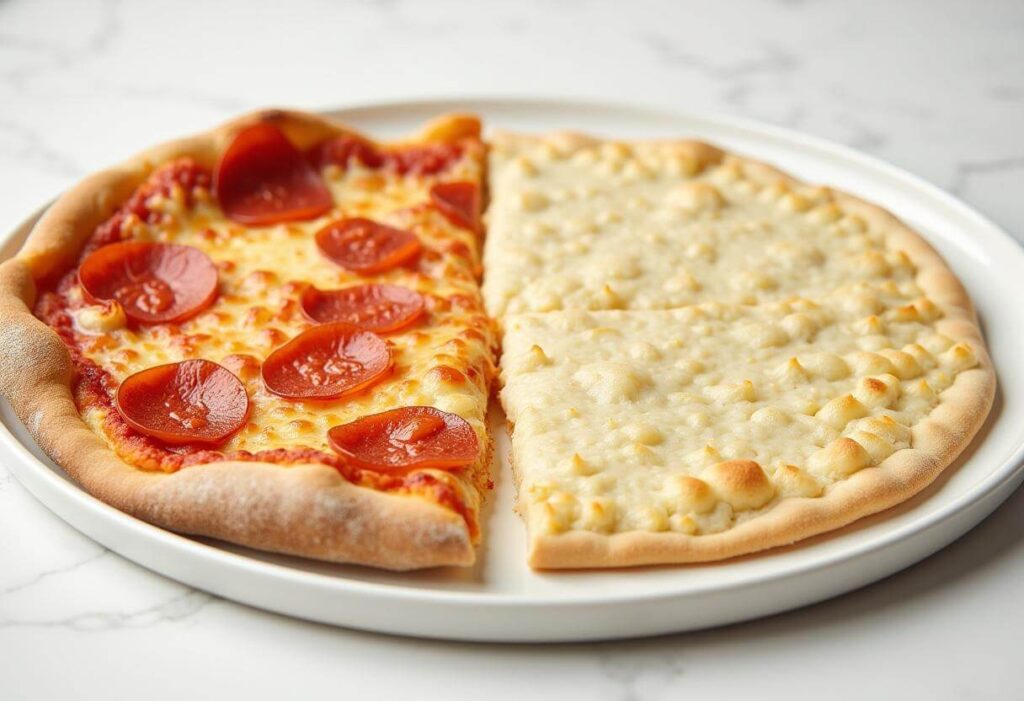
First and foremost, cauliflower is a nutrient powerhouse. Packed with vitamins C, K, and folate, along with antioxidants, it supports immune health and reduces inflammation. Unlike standard wheat-based crusts, cauliflower crusts are naturally low in calories and carbohydrates. This makes them ideal for those managing their weight or following low-carb plans like keto.
Is Cauliflower Crust Pizza Really Healthier?
Cauliflower crust pizza has gained popularity as a healthier alternative to traditional and gluten-free crusts, but what makes it stand out? If you’re curious about the nutritional differences and why it’s often considered a better option, you can explore the full breakdown in our detailed guide: Is Cauliflower Crust Pizza Really Healthier?.
Ingredients for Vegan Cauliflower Pizza Crust
Crafting the perfect vegan cauliflower pizza crust recipe starts with simple, wholesome ingredients. Here’s everything you’ll need to make a flavorful and sturdy crust that’s also gluten-free and dairy-free.
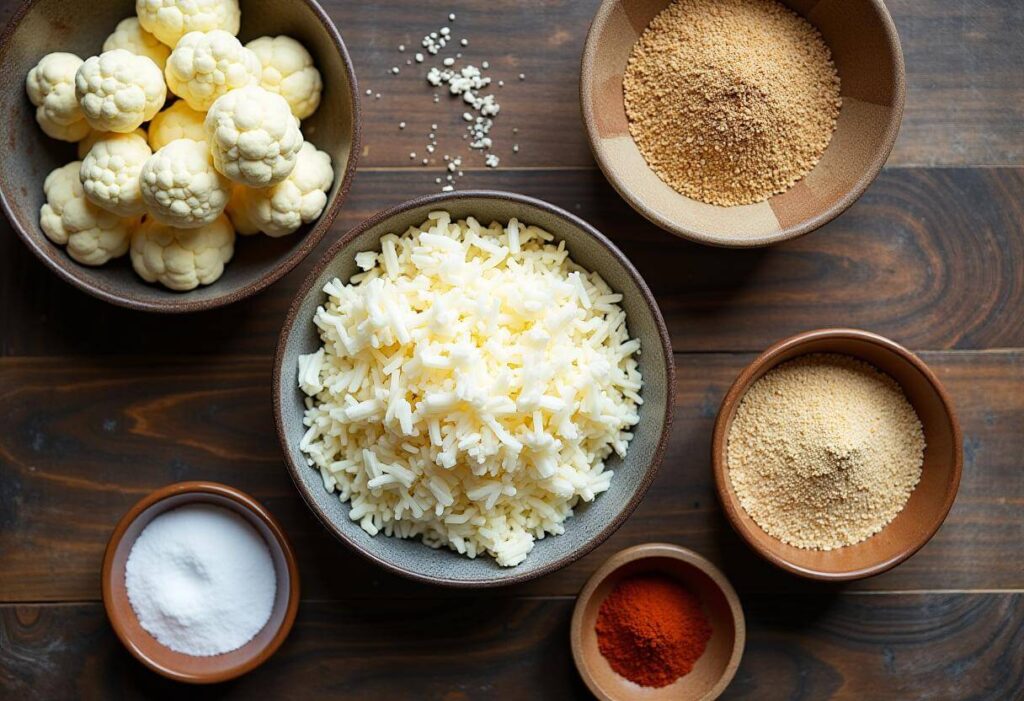
Essential Ingredients
- Cauliflower (1 medium head or 4 cups riced): The star of the recipe, providing the base and a mild flavor.
- Flax Eggs (2 tablespoons flaxseed meal + 5 tablespoons water): A vegan binder that holds the crust together.
- Nutritional Yeast (2 tablespoons): Adds a cheesy, umami flavor without dairy.
- Seasonings: Salt, pepper, garlic powder, and Italian herbs for a flavorful crust.
Optional Ingredients for Variations
- No Flour Option:
- Use almond meal or tapioca starch (¼ cup) for extra binding without traditional flour.
- No Oil Option:
- Replace oil with aquafaba (chickpea water) or just water to keep the recipe lighter.
- 3 Ingredient Cauliflower Pizza Crust:
- Stick to cauliflower, flax eggs, and a pinch of salt for an ultra-minimalist recipe.
Toppings (Optional)
While not part of the crust itself, consider prepping your favorite vegan toppings like marinara sauce, cashew cheese, or roasted vegetables to complement the crust.
By keeping the ingredients flexible, you can customize your crust to suit various dietary preferences. Whether you prefer an oil-free, flour-free, or simple three-ingredient version, this recipe is as adaptable as it is delicious.
Step-by-Step Instructions
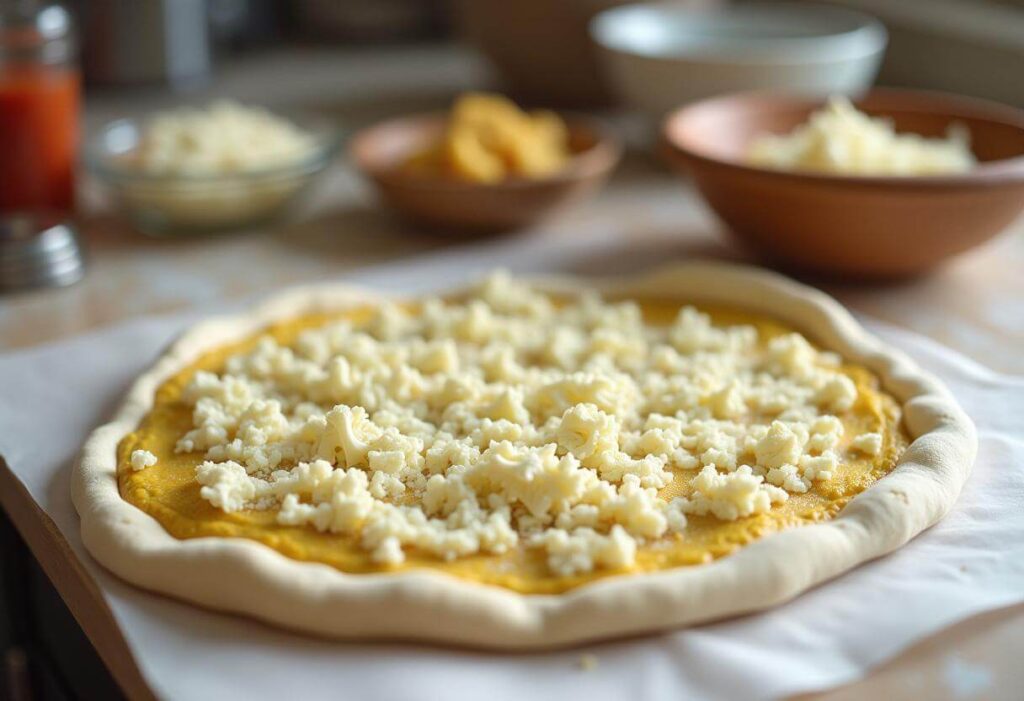
Preparing the Cauliflower
To create the perfect vegan cauliflower pizza crust, start with well-prepped cauliflower. Choose one of these methods to rice your cauliflower:
- Grating: Use a box grater to shred the cauliflower into rice-sized pieces. This method is simple but requires a bit of elbow grease.
- Food Processor: Chop the cauliflower into florets, then pulse them in a food processor until the texture resembles rice. Be careful not to over-process.
- Pre-Riced Cauliflower: Save time by using store-bought pre-riced cauliflower. Fresh or frozen options both work, but ensure it’s thawed and drained if frozen.
After ricing, cook the cauliflower by steaming or microwaving it for 3–5 minutes. Once cooled, transfer it to a clean kitchen towel and squeeze out as much moisture as possible. Removing excess water is essential to avoid a soggy crust.
Mixing the Dough
In a large bowl, combine the prepared cauliflower with the following:
- 2 flax eggs (or chia eggs) for binding.
- Seasonings like garlic powder, Italian herbs, and nutritional yeast for flavor.
- Optional almond meal or tapioca starch for added structure.
Mix thoroughly until the ingredients form a dough-like consistency. If the mixture feels too wet, add a small amount of almond meal or tapioca starch. The dough should be sticky but not overly moist.
Shaping and Baking the Crust
- Pressing and Shaping: Place the dough on a sheet of parchment paper. Shape it into a circle or rectangle about ¼-inch thick. Even thickness is key for even baking.
- Baking: Preheat your oven to 400°F (200°C). Transfer the parchment paper with the crust onto a baking sheet or pizza stone. Bake for 20–25 minutes, or until the edges start to turn golden.
How Do You Make cauliflower Crust Crispy?
For a crispier crust:
- Flip the crust after the initial bake and cook for an additional 5–10 minutes.
- Use a pizza stone for better heat distribution.
- Ensure the cauliflower is thoroughly squeezed to remove excess moisture before mixing.
With these tips, you’ll achieve a deliciously crispy base ready for your favorite toppings!
Tips for the Best Vegan Cauliflower Pizza Crust
Crafting the perfect vegan cauliflower pizza crust recipe requires a few essential techniques to ensure it’s both delicious and sturdy. If you’ve ever struggled with a crust that falls apart or lacks crispiness, these actionable tips will help you achieve flawless results every time.
Why Does My Cauliflower Pizza Crust Fall Apart?
The most common issue with cauliflower crusts is crumbling. Here’s how to prevent it:
- Properly Squeeze Moisture: After cooking the cauliflower, use a clean kitchen towel or cheesecloth to squeeze out as much moisture as possible. Wet cauliflower leads to a mushy texture, making the crust prone to breaking.
- Use Effective Binders: Ingredients like flax eggs or chia eggs play a crucial role in holding the crust together. Ensure you’ve mixed them thoroughly with the cauliflower and other ingredients.
- Don’t Skip the Pre-Bake: Baking the crust before adding toppings helps it firm up and prevents it from becoming soggy during the final bake.
Achieving Crispiness Without Burning
A crispy crust is essential for a satisfying pizza experience. Here’s how to get it right:
- Even Thickness: Shape the crust evenly to about ¼-inch thick. Thin spots may burn, while thicker areas might remain soggy.
- Use Parchment Paper: This prevents sticking and allows for even cooking. Avoid wax paper, which isn’t oven-safe.
- Bake at the Right Temperature: Stick to 400°F (200°C) for optimal crispiness without burning.
- Flip for Extra Crunch: After the initial bake, carefully flip the crust and bake for an additional 5–10 minutes. This ensures both sides are crispy.
With these tips in mind, you’ll avoid the pitfalls of crumbling and sogginess, ensuring a crust that’s as sturdy as it is delicious. Whether you’re a first-timer or a seasoned pro, mastering these techniques will elevate your pizza-making game!
Variations and Customizations
One of the greatest advantages of a vegan cauliflower pizza crust recipe is its flexibility. With just a few tweaks, you can adapt the recipe to suit different dietary needs and flavor preferences. Here are some tips for creating variations that are sure to please every pizza lover.
Dairy-Free Options
For those avoiding dairy, the crust itself is already a win. To enhance the flavor or create a cheesy effect without dairy, consider these options:
- Vegan Cheese Substitutes: Add a sprinkle of nutritional yeast to the dough for a cheesy, umami flavor.
- Cashew Cream: Drizzle cashew cream or almond ricotta on top of your finished pizza as a dairy-free alternative to mozzarella.
- Store-Bought Vegan Cheeses: Brands like Violife or Miyoko’s offer meltable vegan cheeses to top your pizza.
Gluten-Free Alternatives
If you’re looking to add more structure without traditional flour, try these gluten-free binders:
- Almond Meal: A great way to enhance the nutty flavor and texture of the crust. Use about ¼ cup to balance moisture.
- Tapioca Starch: Helps create a firmer crust that’s easy to handle, especially for thin crust lovers.
Quick Recipes with Minimal Ingredients
Pressed for time? The dairy-free cauliflower pizza crust recipe can be simplified without sacrificing taste:
- Use just three ingredients: riced cauliflower, flax eggs, and salt.
- Skip pre-cooking by using frozen, pre-riced cauliflower that’s thawed and well-drained.
- Bake directly after mixing to cut down on prep time.
By experimenting with these variations, you can make the recipe your own. Whether you’re crafting a dairy-free masterpiece or seeking a quick and gluten-free option, this adaptable crust offers endless possibilities.
FAQs
What is Cauliflower Pizza Crust Made Of?
Cauliflower pizza crust is crafted from a few simple, wholesome ingredients designed to mimic traditional crust without using wheat or dairy. The main ingredient is riced cauliflower, but there’s much more to its unique composition. To learn about the full list of ingredients and how they work together to create this healthy alternative, check out our guide: What is Cauliflower Pizza Crust Made Of?.
Why Does My Cauliflower Pizza Crust Fall Apart?
A common issue with cauliflower pizza crust is its tendency to crumble or fall apart. The main causes are often related to moisture content, insufficient binding agents, or baking techniques. However, solving these challenges requires a bit of precision and understanding.
For a complete guide on troubleshooting these issues, including tips on removing excess moisture, choosing the right binders, and pre-baking techniques, read the full article: Why Does My Cauliflower Pizza Crust Fall Apart? Tips & Fixes.
Is Cauliflower Crust Pizza Really Healthier?
Cauliflower crust pizza is often a healthier option compared to traditional or even some gluten-free crusts. Traditional crusts contain up to 300 calories and 40 grams of carbs per serving, while a typical cauliflower crust has around 120 calories and 9 grams of carbs.
Additionally, cauliflower is rich in vitamins C and K, along with antioxidants that support overall health. Compared to gluten-free crusts made with rice or almond flour, cauliflower crusts are lower in calories and carbs, making them an excellent choice for weight management and low-carb diets.
Switching to a cauliflower crust lets you indulge in pizza without the guilt, while reaping the nutritional benefits of this versatile vegetable.
To find out more about why cauliflower crust is considered a better option for certain diets, you can read our full guide: Is Cauliflower Crust Pizza Really Healthier?.
Serving Suggestions and Storage Tips
Once your vegan cauliflower pizza crust recipe is perfectly baked, the next step is to customize it with delicious toppings and ensure any leftovers are stored and reheated correctly.
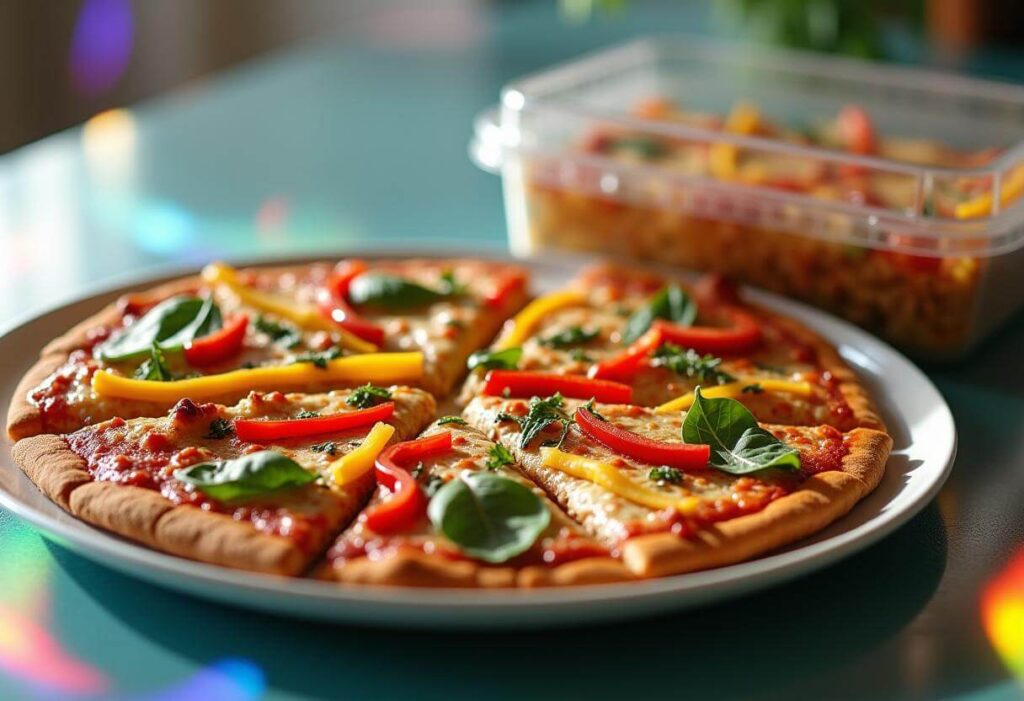
Topping Ideas for Your Vegan Cauliflower Crust
This crust pairs beautifully with a variety of plant-based toppings. Here are some ideas to inspire your next pizza creation:
- Vegan Cheese: Try cashew cheese, almond ricotta, or store-bought vegan mozzarella for a creamy, melty finish.
- Fresh Vegetables: Load up with tomatoes, bell peppers, mushrooms, zucchini, spinach, and red onions for a nutrient-packed feast.
- Protein-Rich Options: Add marinated tofu, tempeh, or chickpeas for a protein boost.
- Flavor Enhancers: Sprinkle nutritional yeast, fresh basil, or a drizzle of balsamic glaze for extra flavor.
- Themed Pizzas:
- Mediterranean: Add kalamata olives, artichoke hearts, and sun-dried tomatoes.
- BBQ: Spread a vegan BBQ sauce base with grilled jackfruit and red onions.
Storing Leftovers
If you have leftovers, you’re in luck! This crust stores well when handled properly:
- Refrigeration: Allow the pizza to cool completely, then store slices in an airtight container in the refrigerator for up to 3 days.
- Freezing: Wrap the crust (plain or topped) tightly in plastic wrap, followed by foil. Store in the freezer for up to 2 months.
Reheating Tips
To maintain the crust’s texture, avoid microwaving, as it can make the crust soggy. Instead:
- Oven Method: Preheat to 375°F (190°C), place the slices on a baking sheet, and heat for 8–10 minutes.
- Skillet Method: Heat a non-stick skillet over medium heat and warm slices for 5 minutes, ensuring a crispy base.
With these serving and storage tips, you can enjoy your cauliflower pizza crust fresh or as a convenient leftover meal.
Conclusion
Making a vegan cauliflower pizza crust recipe is a rewarding way to enjoy pizza without compromising on health or flavor. This crust is gluten-free, dairy-free, and low in carbs, making it a perfect choice for various dietary preferences. With its versatility, you can customize it with your favorite toppings, whether you’re craving a classic margherita or a veggie-loaded feast.
The process is simple and fun, and the end result is a delicious, crispy crust that supports your healthy lifestyle. Plus, with endless variations—like no oil or flour-free options—you can tailor the recipe to suit your needs.
Why not give this recipe a try? Experiment with the tips and techniques shared here to create your perfect crust. Once you taste the balance of crispiness and flavor, you’ll see why this recipe is a game-changer for pizza lovers everywhere.
Related Articles

